What Is Email Segmentation? Guide to Effective Marketing Strategies

Can email segmentation really improve your email marketing performance?
Absolutely!!
Email is still one of the most powerful channels for eCommerce brands. However, sharing the same email with your entire list is like trying to sell winter coats in the middle of summer to everyone.
It’s ineffective, outdated, and gets easily ignored in the inbox.
The smarter brands have figured this out. They’re using an email segmentation strategy and eCommerce paid ads to send the right message to the right people. In fact, HubSpot’s 2023 State of Marketing Report found that segmented campaigns drive 30% higher open rates and 50% more clicks than non-segmented ones.
The idea is simple: divide your email list into meaningful groups, send each group a personalized message, and watch your engagement and conversion rates skyrocket.
In this guide, we’ll cover:
- What email segmentation really means
- The biggest benefits for your eCommerce brand
- The most valuable types of segments to create
- Practical steps to get started
- 10 proven email segmentation strategies you can apply right away
Let’s get into it.
What Is Email Segmentation?
Email segmentation is the process of dividing your email list into targeted groups based on factors like demographics, behavior, purchase history, or engagement levels.
In simple terms, email marketing segmentation means dividing your email list into smaller, more targeted groups. These groups can be based on:
- Demographics (such as age and location),
- Behavior (including browsing activity),
- Purchase history (first-time buyers vs. loyal customers),
- Engagement levels (active vs. inactive subscribers).
Instead of pushing out one-size-fits-all email segmentation campaigns, you tailor your message for each segment of your email lists using customer data.
A loyal customer might get early access to a product drop, while a new subscriber receives a welcome offer. Higher engagement, stronger customer relationships, and better conversion rates, without increasing send volume.
Email segmentation isn’t just a nice-to-have anymore. For brands serious about growth, it can create a huge difference between being seen and being ignored.
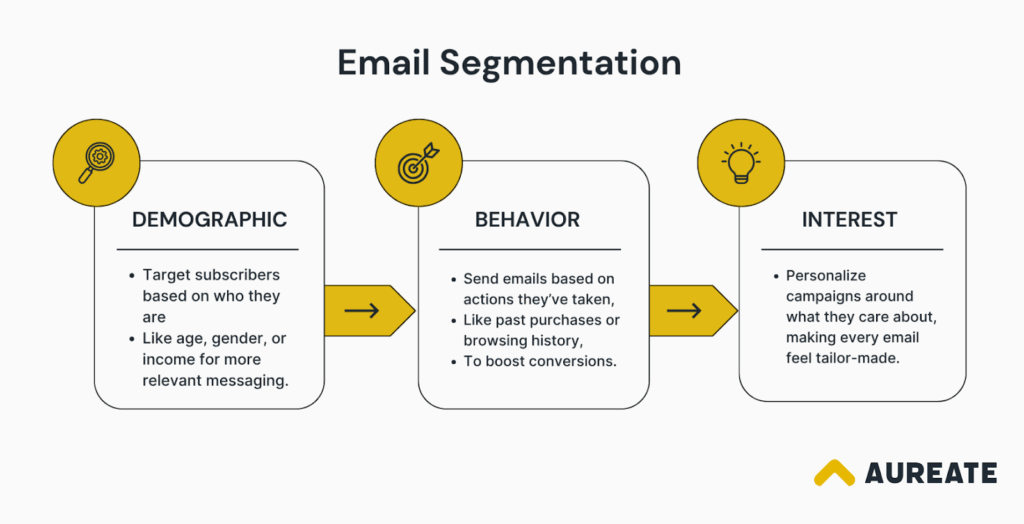
What are the Benefits of Email Segmentation?
One of email segmentation’s biggest strengths is its ability to deliver targeted messages on both small and large scales. Unlike social media marketing and TV advertisements, which target huge mass audiences and hope for the best, email marketing segmentation strategies allow you to craft content for specific criteria, making each email feel more personal even though it’s automated.
This isn’t just about sending fewer emails; it’s about sending smarter ones. When done right, target audience segmentation boosts open rates, click through rates, and even customer loyalty by showing subscribers that you genuinely understand them.
Let’s discuss each of its benefits one by one.
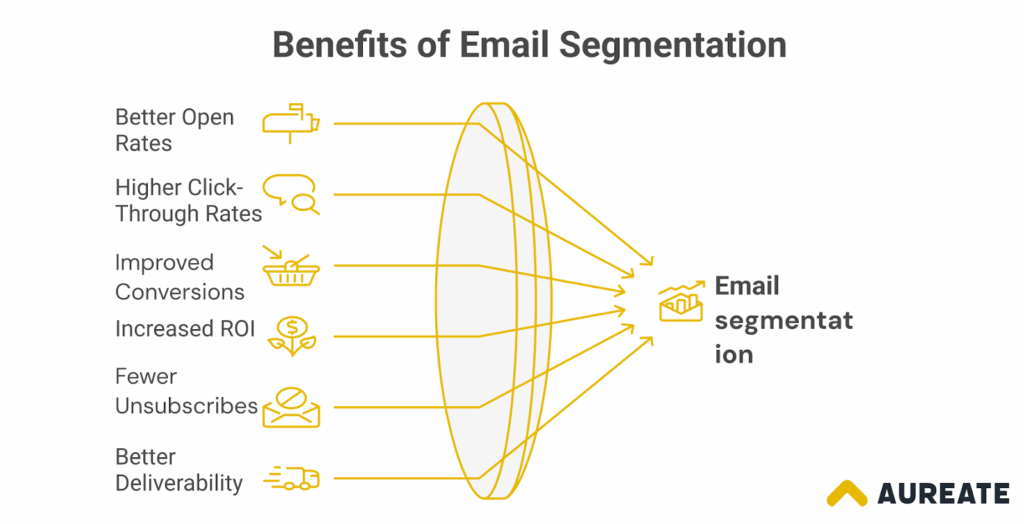
1. Better Open Rates
Make the First Impression Count. You wake up in the morning, open your inbox, and it’s overflowing with emails. Which one gets your click first?
Naturally, the one that feels personal and actually matters to you.
The average email open rate hovers around 32.55%. Segmented campaigns are stealing the show with a 30% boost.
Why? Because they address a subscriber’s exact needs by utilizing customer preferences.
When you know who’s reading, your subject lines stop being generic and start being irresistible.
Pro Tip: Use your highest-performing email segments to create lookalike audiences for paid ads – this can increase ad conversion rates by 2-3x. Our eCommerce paid ads team can help you bridge email data with Facebook and Google campaigns for maximum impact.
2. Higher Click-Through Rates
Once they have opened the email, personalization comes into action.
The average click-through rate stands at 1.11% for the retail industry, but segmented emails outperform this rate because they deliver content worth exploring.
Email segmentation lists and Segmented campaigns deliver content that feels useful, prompting subscribers to click through, whether it’s to check out a limited-time sale or explore a new product line.
3. Improved Conversions
When subscribers see content tailored to their stage in the customer journey, they’re more motivated to take action. This “closer to the finish line” effect, known in psychology as the goal gradient effect, can mean more purchases, sign-ups, or event registrations.
Want your emails to drive even more conversions? Pair personalized email segmentation marketing with optimized store experiences through our eCommerce UI/UX design services.
4. Increased ROI
Every segmented email acts like a mini sales pitch customized to the recipient using behavioral data.
In fact, email marketing continues to outperform social media by up to 40x in customer acquisition. By honing in on the target audience, you minimize wasted spend, ensuring that every dollar invested in targeted email marketing generates greater returns.
5. Fewer Unsubscribes
People unsubscribe for one main reason: irrelevance.
When every email lands with a “This is for me” vibe, people stick around. Customer email segmentation ensures subscribers feel like insiders. It must not just be another email address on your list. And the longer they stay, the more valuable they become.
6. Better Deliverability
Here’s the hidden cost of irrelevant emails: even if people don’t unsubscribe, they might stop opening or worse, mark you as spam folder..
Personalized email marketing is not just a good-to-have thing; it’s the backbone of effective targeted email marketing. Start small, test what resonates, and you will quickly see how targeted campaigns turn casual subscribers into loyal customers.
Make email segmentation effortless with automation. Read our guide: Email automation with Dotdigital: Why and How?
Primary Types of Email Segmentation
In this segment, we are sharing seven smart email segmentation types that can boost your conversions and earn customer loyalty.
Grab your coffee or tea, and let’s learn the 7 customer email segmentation types.
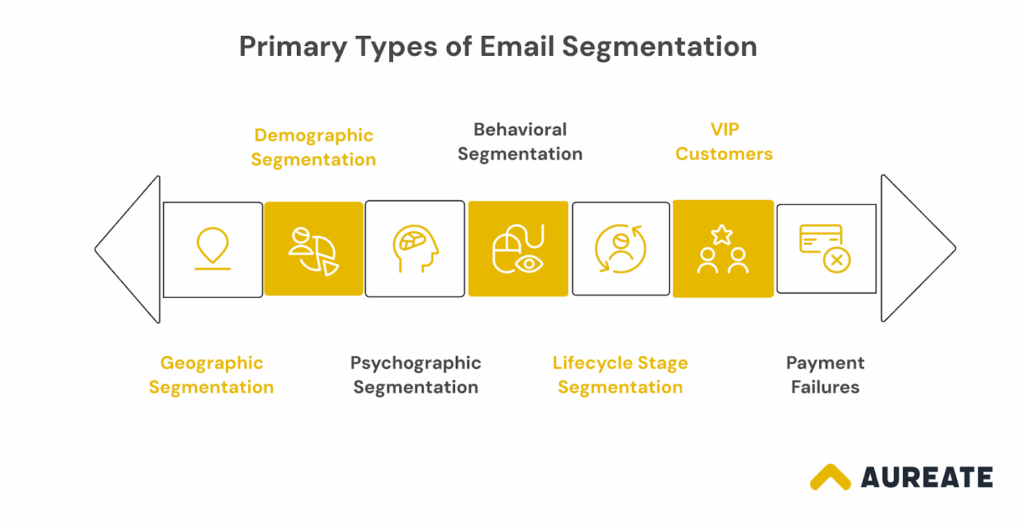
1. Demographic Segmentation
Demographic email segmentation means dividing your audience based on factors like age, gender, income, education, or occupation using demographic data. It helps you send more relevant emails that match who your target customers are and what they need.
These details often shape how people make buying decisions.
If you launched a new skincare line. Instead of sending the same announcement to everyone, you segment your email list.. Men get an email highlighting aftershave and grooming products. Women receive tips and routines tailored to their skin types.
This will turn into a great number of opens, more clicks, and loyal customers who feel like you write only for them.
2. Behavioral Segmentation
If demographics tell you who someone is, behavioral email segmentation tells you what they care about right now.
This is where you watch what people do, clicks, browsing habits, purchases, abandoned carts, and respond with emails that match their actions using behavioral data.
If you have an online bookstore.
Fiction lovers get novel recommendations; professionals get industry tutorials. If someone keeps eyeing a product without buying, send a nudge with a review or a special offer.
It’s like being a shop assistant who guides you straight to your needs.
3. Psychographic Segmentation
Email segmentation like going beyond what people buy to understand why they buy.
We’re talking about values, interests, and lifestyles – understanding customer behavior at a deeper level.
You run an online coffee store. Through a quick quiz, you gather data and learn that some customers are “coffee purists” who value artisanal, single-origin beans.
While others are “coffee experimenters” who love trying new flavors and brewing gadgets.
Instead of sending the same newsletter to both, purists get emails about limited-edition Ethiopian roasts and farm stories, while experimenters receive bundle offers on seasonal flavors and innovative coffee makers.
Both feel like you’re speaking directly to their coffee lifestyle.
4. Geographic Segmentation
Email segmentation where your customers live, can completely change how you market to them based on geographic location.
If you’re a fashion retailer, Chicago customers in January are dreaming of warm coats. Los Angeles customers want amazing summer collections.
Send weather-specific promotions, adjust send times to match time zones, and even promote local events.
It’s the difference between offering ice cream in winter versus hot cocoa; timing and context matter for targeted campaigns.
5. Lifecycle Stage Segmentation
Not all email subscribers are in the same stage of their journey with your brand. Some have just met you. Others are loyal buyers. Some haven’t shown up in months.
If you run an online pet store, a new subscriber gets a warm welcome email with a “starter kit” for pet care. A loyal customer might get sneak peeks at upcoming products.
The email segmentation sends the right message at the right time, keeps the journey feeling smooth – never spammy.
6. VIP Customers
Every business has that golden group of customers who spend more, shop often, and rave about you. You should treat them like royalty.
A gourmet coffee brand might give VIPs early access to limited-edition blends. They could also invite them to beta-test new flavors or join a referral program.
These small touches turn casual fans into lifelong advocates – and their loyalty often pays for itself many times over.
7. Payment Failures & Subscription Expiry
This is the audience segmentation most marketers forget, but it’s a goldmine for retaining revenue.
If a customer abandons their cart or a limited-time offer is about to expire, that’s your cue. Send a friendly reminder, include a direct checkout link, or sweeten the deal with a small discount code or free shipping.
An online fashion store might send a 3-step sequence: first, a gentle “You left something behind” reminder, then a style-focused nudge showing how great the items look, and finally, a “last chance” email highlighting that their size or color might sell out soon.
Can I spill the tea?
The secret is that these seven audience email segmentation types are not meant to be used in isolation. The real magic happens when you combine them.
Pairing behavioral data with geographic location to send a hyper-relevant campaign.
Start with these foundations, and your emails will stop feeling like generic emails. Instead, they will feel like handwritten love notes to the right person, at the right time, with the right offer.
How to Create Segments in Email Marketing
When you do not treat your audience as one big, faceless group, that’s where email segmentation comes in; it helps you break your email list into smaller, targeted groups so every message feels relevant. By sending the right message to the right people, you boost customer engagement, build stronger relationships, and drive more conversions.
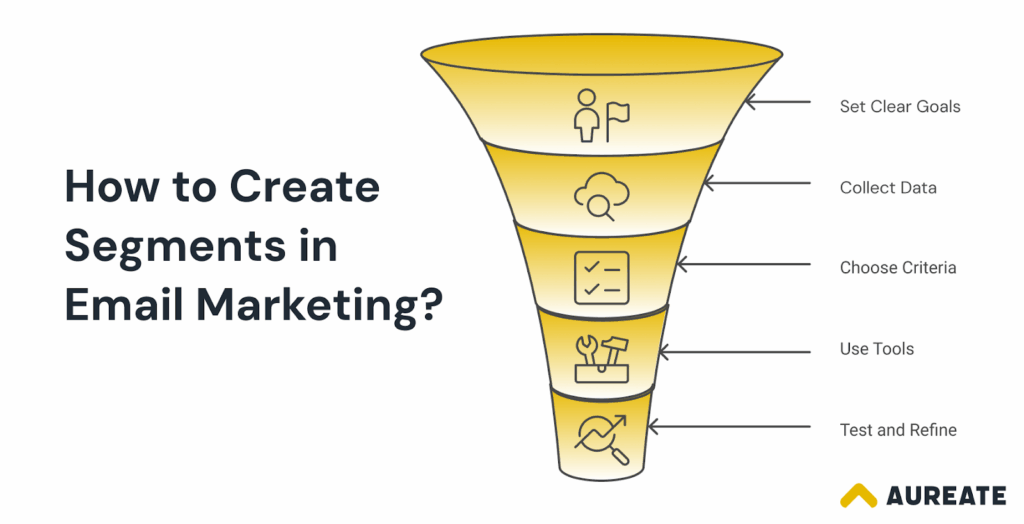
Step 1: Start with Crystal-Clear Goals
Before you even think about splitting your list, get clear on why you’re segmenting. Your goal determines the type of email segmentation you’ll create.
- If you want more mail opens and clicks? Focus on personalization like segmenting by demographics or interests to make every subject line and offer feel relevant.
- If you want to boost loyalty and retention? Target your most engaged customers with VIP perks, thank-you emails, or exclusive discounts.
- If you want to re-engage inactive subscribers? Build a reactivation campaign tailored to people who haven’t interacted with you in a while.
If it’s abandoned cart recovery, you’ll segment based on browsing and purchase intent. If it’s increasing lifetime value, you’ll zoom in on VIP customers for upsells and cross-sells. Without a clear goal, email segmentation is just list-splitting with extra steps.
Step 2. Collect the Right Data
An email segmentation strategy is only as powerful as the customer data you feed it. Luckily, you probably already have more than you think!
The basics, such as Name, email, and location that you collected during sign-up through sign up forms, as well as behavioral data like browsing history, products clicked, past purchases, and engagement clues, including who’s opening, who’s clicking, and how often, you have all that subscriber data stored with you.
If you need more data, you can just add a question to your sign-up form, throw in a one-question poll in your welcome email, or simply track which links people click most often.
Build it piece by piece and collect the data, and be ready for the next email segmentation step.
Step 3. Choose Segmentation Criteria
Once you have data, decide how you will group customers. Your email segmentation criteria will depend on your goals, but common approaches include:
- Demographic: age, gender, income, or profession.
- Behavioral: browsing, clicks, abandoned carts.
- Lifecycle stage: new customers vs. repeat buyers vs. inactive subscribers.
Avoid over-complicating things at the start. Begin with two or three core segments, then add layers as you gather more insights.
4. Build the Segments
Email segmentation is like organizing a closet; you can sort by season, color, or “things I promise I’ll wear again.” The right email marketing software and email service providers make it easier to slice your audience. You can find many paid and free email marketing platform options in the market, such as Mailchimp and Klaviyo.
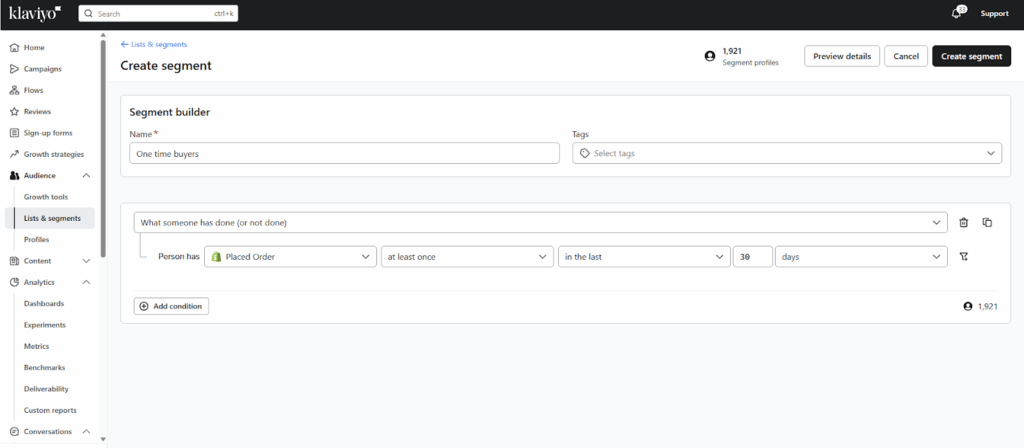
Whichever email marketing platform you are using, you can start with small email segmentation, keep it manageable, and resist the urge to email segments with dozens of micro-segments right out of the gate.
The segment process and conditions would be different for every tool. Follow the tool-specific steps or guidelines to build those segments with the required criteria.
5. Test and Refine
Email segmentation needs regular updates as your customers and their habits change.
Your audience’s interests, habits, and needs change over time, and so should your segments. Regularly review how each segment performs using email metrics: which emails get opened, clicked, or ignored.
Adjust your criteria, add new audience segments, or merge outdated ones. This ongoing refinement ensures your email campaigns stay relevant, engaging, and effective.
Not sure what the most effective email marketing strategy is? Our eCommerce marketing experts can help you set up email segmentation that scales with your business.
10 Email Segmentation Strategies to Create Real Conversions
The fastest way to make your subscribers hit unsubscribe is to send emails that feel irrelevant, repetitive, or flat-out random. People don’t just dislike generic emails; they ignore them, delete them, and eventually,you will get zero conversations.
Smart email segmentation strategies will fix that. These 10 strategies will help you segment smarter, start real conversations, and drive stronger results.
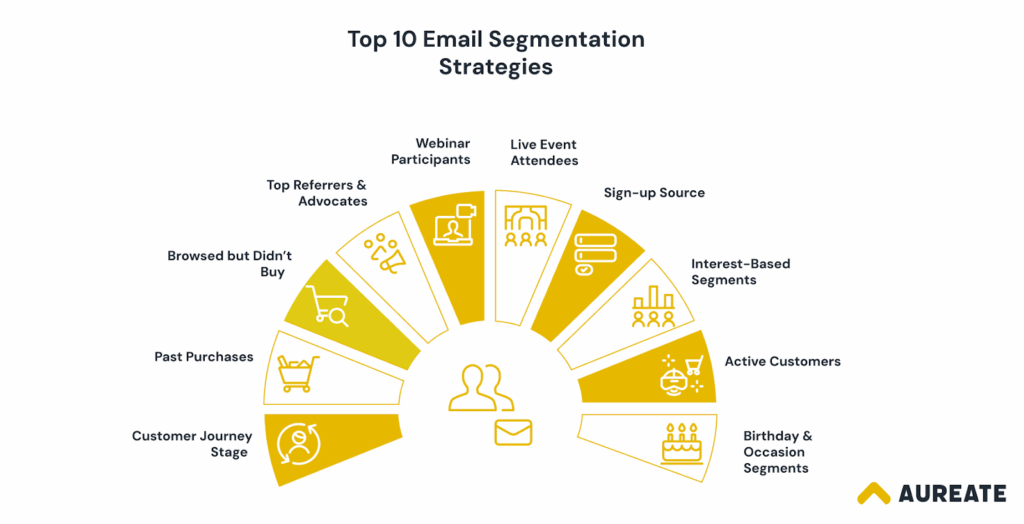
1. Customer Journey Stage Segmentation
Your subscribers are not all at the same stage with your brand, yet most businesses treat them identically. Journey-based email segmentation recognizes that a first-time visitor needs different messaging and a loyal customer needs different one.
Here’s how to approach each stage:
- Awareness (Days 1–7): New subscribers don’t need a sales pitch — they need trust. Send a welcome series with founder stories, customer testimonials, and helpful content that shows your expertise without overwhelming them.
- Consideration (Days 8–30): These prospects are curious but not ready to buy yet. Give them product education, comparison guides, and content that tackles common objections. Focus on value, not just pushing the sale.
- Purchase Stage: High-intent shoppers are primed to act. Send them tailored offers, limited-time discounts, or product recommendations based on what they’ve browsed.
- Retention: Keep your paying customers coming back with loyalty rewards, exclusive content, and cross-sells that make their first purchase even more useful.
- Win-Back: Dormant subscribers need a reason to re-engage. Try special offers, preference updates, or a simple “we miss you” survey to learn what they want now.
Pro tip: Don’t rely only on rigid timelines. Use progressive email segmentation profiling (tracking real behaviors like clicks and purchases) to refine where subscribers actually are in their customer journey. Brands that do this see up to 40% more relevant engagement compared to static, time-based rules.
2. Purchase Behavior Segmentation
Your customers’ past purchases are one of the strongest signals for what they’ll buy next. By mapping buying patterns using purchase history, you can anticipate needs, send timely recommendations, and increase order value without overwhelming your email segmentation list.
Here’s how to use it effectively:
| Strategy | How It Works | Example |
| Complementary Products | Suggest add-ons that naturally follow a purchase | Running shoes → socks, fitness tracker |
| Reorder Timing | Trigger reminders before customers run out | Protein powder → reminder at 25 days |
| Upgrade Path | Move customers from entry-level to premium with education | Basic plan → Pro plan with advanced features |
| Cross-Category Suggestions | Surface surprising but high-converting product combos | Laptop buyers → ergonomic chair |
Brands that segment by purchase behavior often see a 15–25% lift in average order value and 30–40% stronger revenue attribution compared to generic campaigns.
3. Engagement Scoring and Intent Signals
Not every email subscriber on your list is at the same level of interest. Some are ready to buy, some are curious but not convinced, and others are barely paying attention. Engagement scoring helps you separate these groups so you can tailor your email segmentation accordingly.
For example, high-intent subscribers are the ones adding products to their cart, checking pricing pages, or browsing multiple items within a short time. They’re signaling urgency, so your emails should meet that energy with cart abandonment reminders, limited-time offers, or even a personal touch like live chat support.
Medium-intent subscribers show interest, but they’re not quite ready to pull the trigger. They might spend time on category pages, read product-related blogs, or consistently open your emails. Instead of pushing discounts too soon, email segmentation will guide them with educational content, customer success stories, and comparison guides that build confidence.
Then there are the low-intent contacts. These people who bounce quickly from your site or haven’t opened an email in months. For them, the goal isn’t to sell immediately but to re-engage. Share brand stories, highlight what makes your products different, and invite them to update their preferences so you can send more relevant emails.
The more you match your messaging to real engagement signals, the fewer irrelevant emails you send and the more likely subscribers are to stick around, engage, and eventually convert.
4. VIP Customers & Brand Advocates
Your VIPs aren’t just repeat buyers; they’re the ones who spend more, recommend your brand, and actively engage with your community. Treating them like everyone else is a missed opportunity in email segmentation.
A smart VIP program goes beyond generic loyalty points. High-spending target customers (your top 10% by lifetime value) deserve perks like dedicated support, exclusive discounts, or early product access. Socially active advocates like the ones leaving reviews, tagging you on Instagram, or referring friends, should be rewarded with sneak peeks, co-marketing opportunities, or special recognition.
And don’t forget the highly engaged subscribers who open every email, join surveys, or participate in your community; they thrive on being heard, so give them direct input on new features or campaigns.
Some of your most passionate VIPs may even be product evangelists like early adopters who test new items, share feedback, and create content around your brand. Bringing them into beta programs or giving them first access not only strengthens loyalty but also makes them feel like true partners in your growth.
Pro Tip: You can export your VIP segments as custom audiences in ad platforms to show them premium products while excluding them from discount ads. Our eCommerce paid ads specialists can integrate your email segments with an advertising strategy for better ROI.
The more you identify segments and nurture these VIP segments, the more you’ll see them transform from loyal customers into brand advocates who drive both revenue and influence.
5. Event Participation and Educational Engagement
Webinar attendees and educational content consumers represent highly engaged prospects who’ve invested time in learning about your industry. These email segmentations require specialized nurturing that builds on their demonstrated commitment to education and improvement.
Here’s a simple 4-phase framework to maximize that customer engagement:
1. Pre-Event → Build anticipation with speaker spotlights, agenda teasers, and bonus resources.
2. During Event → Drive interaction through live polls, Q&A, and chat engagement.
3. Post-Event → Follow up with recordings, step-by-step guides, and consultation offers.
4. Long-Term → Keep the relationship alive with alumni groups, continuous learning, and exclusive community access.
Instead of treating events as one-off touchpoints, this approach nurtures attendees before, during, and after turning them into long-term brand advocates.
6. Acquisition Source
The way someone joins your email segmentation list says a lot about what they expect from you. By tracking acquisition sources, whether it’s a blog, social ad, referral, or resource download, you can personalize onboarding and follow-ups that feel more personal and relevant.
Here’s how to use it:
- Organic Search: Subscribers found you while researching, so keep feeding them educational content that builds on their intent.
- Social Media: These sign-ups are visual-first. Use bold imagery, testimonials, and social proof to hold their attention.
- Paid Ads: They clicked for a reason. Reinforce value with direct, benefit-driven messaging that justifies their choice.
- Referrals: Trust is already high. Acknowledge where they came from and nurture that relationship with community-driven content.
- Content Marketing (blogs, guides, downloads): Deliver in-depth resources and follow-ups that expand on the exact topics they engaged with.
When you match onboarding to acquisition source, you increase engagement, build stronger trust, and focus growth on quality, not just list size.
7. Interest and Preference Personalization
Interest-based email segmentation allows email subscribers to guide their own experience by receiving relevant content that matches their stated preferences and demonstrated behavior patterns. This approach creates relevance that generic messaging simply cannot achieve.
- Use onboarding surveys, preference centers, and direct feedback to understand explicitly stated interests and content preferences.
- Track content consumption patterns, product browsing behavior, and engagement metrics to identify implicit interests and emerging preferences using an analytics platform.
- Monitor how interests change over time and adjust email segmentation accordingly, ensuring your messaging stays current with subscriber needs.
If done well, this kind of personalization doesn’t just feel relevant, but it drives results. In fact, interest-based email segmentation has been shown to boost click-through rates by 50–100% while reducing unsubscribes by up to 30%.
8. Active Customer Optimization
Labeling someone as just an “active customer” doesn’t really tell you much. Some people open every email, click around your site, and share your brand on social; others barely skim your messages.
A better approach is to look at how customer segments engage across different touchpoints, like
- Email metrics show you who’s really reading and clicking.
- Website behavior tells you who spends time exploring versus who bounces quickly.
- Purchase history shows how often (and how much) they buy.
- Social activity highlights natural advocates who talk about your brand.
- Customer support interactions can signal loyalty or frustration.
When you put these pieces together, you can segment the email segmentation with different tiers of engagement. Your most active fans deserve early access, special perks, or VIP treatment. Moderately engaged customers might respond best to rewards or referral incentives. Those who interact less can be kept warm with educational content and regular updates.
The goal isn’t to flood inboxes with more emails; it’s to send the right emails at the right time. When every customer feels like your messages actually match their level of interest, they’re far more likely to stay engaged and keep buying.
9. Geographic and Demographic Intelligence
“Where your customers live and who they are” play a huge role in how they respond to your emails. By layering in location and demographic data, you can make your marketing campaigns feel more personal, timely, and relevant.
Geographic segmentation goes beyond just knowing someone’s country. You can recommend products based on local weather, acknowledge regional holidays, or adapt messaging to cultural preferences.
Even simple tweaks like sending emails at the right local time can significantly boost open rates. And if you sell globally, adjusting pricing, payment options, or promotions based on local conditions makes your brand feel fair and accessible.
Demographics matter too, but not in a generic “age and gender” way. Younger subscribers might prefer visual-heavy emails and mobile-first design, while older audiences may engage better with clear, straightforward messaging.
Someone just starting their career has different needs than a parent with school-aged kids, and income levels often determine whether to highlight premium products or flexible payment options.
Pro Tip: Contact Aureate Labs to create and sync your geographic email segments with paid campaigns to increase ad spend in high-converting locations that increase ad spend in high-converting locations and reduce budget in underperforming areas.
The real power comes when you combine geography, demographics, and behavior for email segmentation. That’s how you move from broad buckets to micro-segments, small, highly relevant groups that respond to campaigns because they feel like the message was written just for them.
10. Milestone and Celebration Marketing
Celebration emails are one of the easiest ways to build emotional connections while also driving extra revenue. Instead of sending a generic birthday discount, milestone marketing can be a way to mark both personal and brand-related moments.
This could mean celebrating personal milestones like birthdays, work anniversaries, graduations, or family events with thoughtful messages and tailored offers. You can also highlight customer journey milestones in email segmentation such as a first-purchase anniversary, hitting a loyalty tier, or reaching a spending threshold.
On a broader level, tie into seasonal and cultural celebrations, whether it’s regional holidays, festivals, or seasonal buying habits, to keep your emails relevant and timely.
And don’t forget to include your customers in your own business milestones. Sharing a product launch, company anniversary, or community achievement is a great way to make them feel part of your brand’s story.
Email segmentation transforms generic marketing campaigns into personalized conversations that drive real business results. These ten strategies provide the framework for creating subscriber experiences that feel custom-built rather than mass-produced.
You can also feed these segments into ad campaigns for even stronger results using eCommerce paid ads.
Final Thoughts
Email segmentation strategies outlined above provide a strong foundation for any eCommerce brand looking to move beyond batch-and-blast messaging.
From demographic email segmentation to interest-based email segmentation, these methods continue to drive real results when executed well as part of a comprehensive marketing strategy.
As customer expectations rise, modern eCommerce brands are increasingly turning to next-gen techniques like,
- AI-powered behavioral predictions
- Cross-device behavior tracking,
- Real-time email segmentation based on live inventory.
These advanced strategies allow for even deeper personalization and smarter timing using customer relationship management systems.
If you’re ready to go beyond the basics and explore what cutting-edge email segmentation looks like today, we’d love to help. Let’s build smarter campaigns together.
Once you’ve nailed your segments, the next step is building powerful sequences. Check out the top 32 email marketing series for ecommerce for inspiration.






Post a Comment
Got a question? Have a feedback? Please feel free to leave your ideas, opinions, and questions in the comments section of our post! ❤️